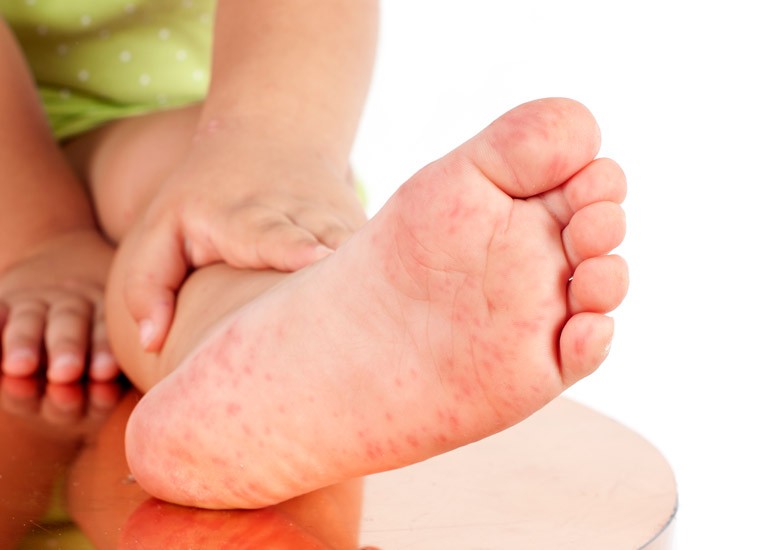Hand, foot and mouth disease (HFMD) is a common childhood viral infection. It used to commonly be a summer virus, but we now see outbreaks all throughout the year. Megan Gruesser, MD, FAAP, a pediatrician at our Carmel practice, helps provide insights into the symptoms, prevention, and treatment of HFMD so you can be equipped with the information you need to keep your child safe.
What is hand, foot and mouth disease (HFMD)?
This common childhood viral infection is almost always safe and is caused by members of the enterovirus family.
The infection usually starts with a mild to moderate fever, achiness and crankiness, and sores inside the mouth and throat. These lesions can look like “canker sores” and cause pain but are often difficult to see in young children. Finally, kids develop the classic HFMD rash which are red flat marks or blisters usually on the palms of the hands, soles of the feet, and buttocks. However, the rash can appear on any area of skin, especially “injured” skin, like patches of eczema. (Sometimes kids only get the throat spots with no rash and that is called herpangina.)
The whole illness usually lasts less than 10 days and resolves without complications. The rash does not leave any scarring.
How do we avoid getting it?
Using hand sanitizer and washing hands is the first step in stopping the spread of most illnesses. Unfortunately, kids start spreading it before they have the classic rash, and occasionally weeks after they appear completely well.
The virus can also spread through water that is not properly chlorinated. To make matters worse, adults can transmit the disease without ever having symptoms!
Parents are often frustrated with other parents or their daycare because they “exposed” their child, but the reality is once the virus is in a childcare setting, everyone will be exposed, even with the best of intentions. “Due to its name, hand, foot and mouth disease gets a bad reputation of being a ‘dirty virus.’ However, it’s a very common childhood illness, and luckily most children only get it once in their lifetime.” states Dr. Gruesser. “And heads up...Parents can get HMFD, too, if they never had it as a kid!”
How do I treat my child if/when they get it?
No antibiotics or prescription medications can shorten this illness. A parent’s goal should be pushing fluids and pain relief for the throat, which includes ibuprofen and/or acetaminophen, ice cream, popsicles, and throat sprays for children over six. Do not use aspirin with children.
Are there any complications I need to look out for?
Yes – dehydration. Occasionally, HFMD can cause children to refuse to drink due to throat pain. In serious cases of dehydration, children may need to be admitted for IV fluids.
Roughly a month after the resolution of HFMD, the child’s skin of their hands and feet may peel. Rarely, their fingernails or toenails may fall off as well. As scary as this sounds, it is painless and the nails grow back normally!
What do I need to contact my doctor about?
For any virus, the fever should be at the beginning of the illness and not go longer than five days. If the fever goes past day five, please call your doctor.
Also, kids should urinate at least four times per day and make tears when they cry. If they don’t, this could be a sign of dehydration. The other main reason to call is change in alertness (a little tiredness and a case of the “crankies” is normal), severe headache or severe fatigue.
Finally, parents should carefully monitor fevers in infants. A fever over 100.4 in an infant under two months old should be seen immediately.
Need a pediatrician? Our exceptional team is here to help. Browse our providers on Find a Doctor and schedule an appointment online.
